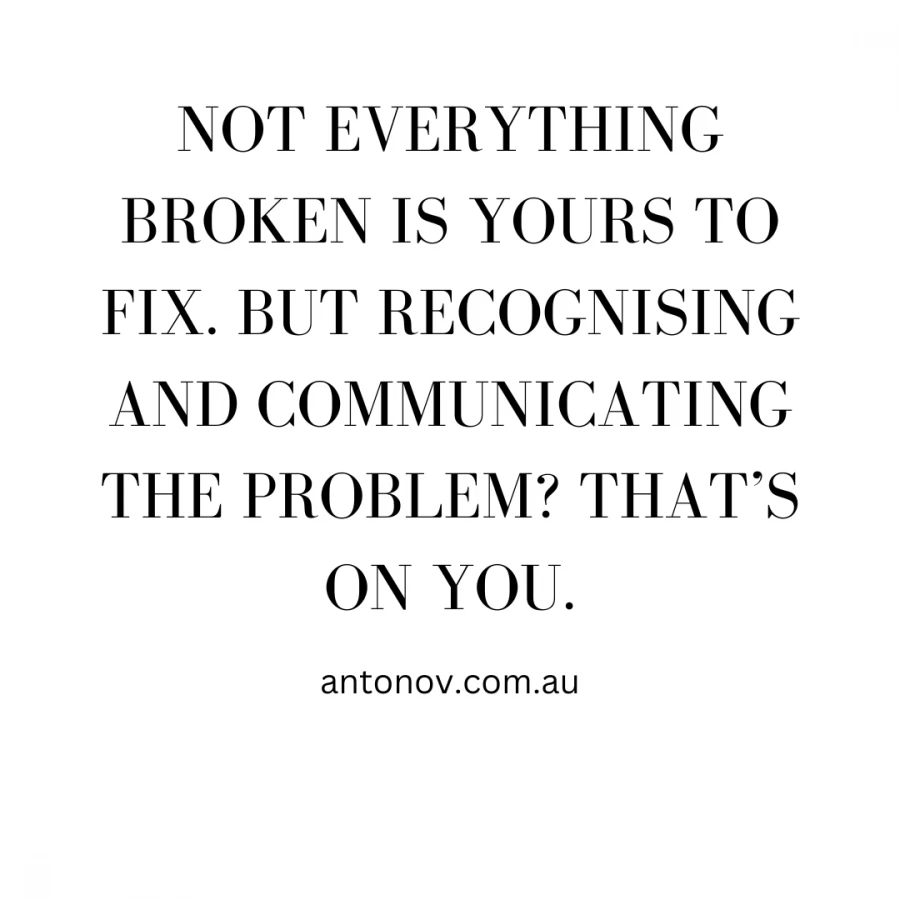Jun 10, 2024
Broken Isn’t Always Yours
If you've ever felt like something's off in your team...a process dragging, communication breaking down or decisions getting delayed but didn't say anything because “it's not your job to fix it,” you're not alone. This is where most teams get stuck. The problem is visible, even painful, but no one names it.
Not everything broken is yours to fix. But seeing the cracks (and calling them out) is your responsibility.
This mindset shift towards naming issues, not owning every solution, creates a culture of accountability, clarity and trust.
You can't fix what you refuse to see.
You can't improve what you won't admit.
Speak up. Say the thing others are avoiding. You might be the reason your team finally moves forward.

Not everything broken is yours to fix. But seeing the cracks (and calling them out) is your responsibility.
Why Naming the Problem Matters
- Silence protects dysfunction. If no one speaks up, the issue lingers.
- Visibility unlocks action. Once a problem is named, the team can start addressing it.
- Leadership starts with noticing, not solving. It begins by making others aware of what you see.
This mindset shift towards naming issues, not owning every solution, creates a culture of accountability, clarity and trust.
Use This When You're Thinking
- “Something feels off, but I don't know if it's my place to say it.”
- “We keep missing deadlines, and no one's talking about why.”
- “The team is frustrated, but no one is speaking up.”
How to Raise Issues Without Overstepping
1. Frame problems with clarity and care
- Use neutral, specific language: “Here's something I've noticed…” or “Flagging this because it might be impacting X…”
- Avoid blame or venting. Focus on patterns, not people.
- Show the impact and include examples if you can.
2. Put it in writing
- A Slack message, email, or note gives your concern weight and clarity.
- It avoids misinterpretation and creates a paper trail. Example: “Quick note: I think our client handoff process is breaking down and here's why.”
3. Avoid overreaching
- You're raising awareness, not presenting a final solution.
- Use phrases like: “This isn't fully baked, but I wanted to raise it” or “Might be worth exploring together.”
4. Choose your timing wisely
- Don't drop a bomb in a high-stakes meeting.
- Consider sharing 1:1 or floating a draft doc first.
- Good timing = better listening.
5. Keep your tone calm and steady
- Assume positive intent, even if things are messy.
- Speak with clarity and respect, even when it's uncomfortable.
- Focus on progress, not drama.
Why This Isn't Optional
Left unspoken, problems compound. They show up in delays, poor collaboration, lost trust and eventually, attrition. People leave teams with unresolved issues they were never invited to surface.You can't fix what you refuse to see.
You can't improve what you won't admit.
Real Ownership Starts Here
Even if you're not the one to fix the issue, naming it might be the first step to solving it. That's leadership. That's culture-building. That's what real ownership looks like.Speak up. Say the thing others are avoiding. You might be the reason your team finally moves forward.

About Max Antonov
I'm a father of three from Sydney, a Product Director and a Product Coach. I write about product management and run the Product Manager community.
Feel free to reach out: [email protected].
Subscribe to receive digest emails (1 per month).
